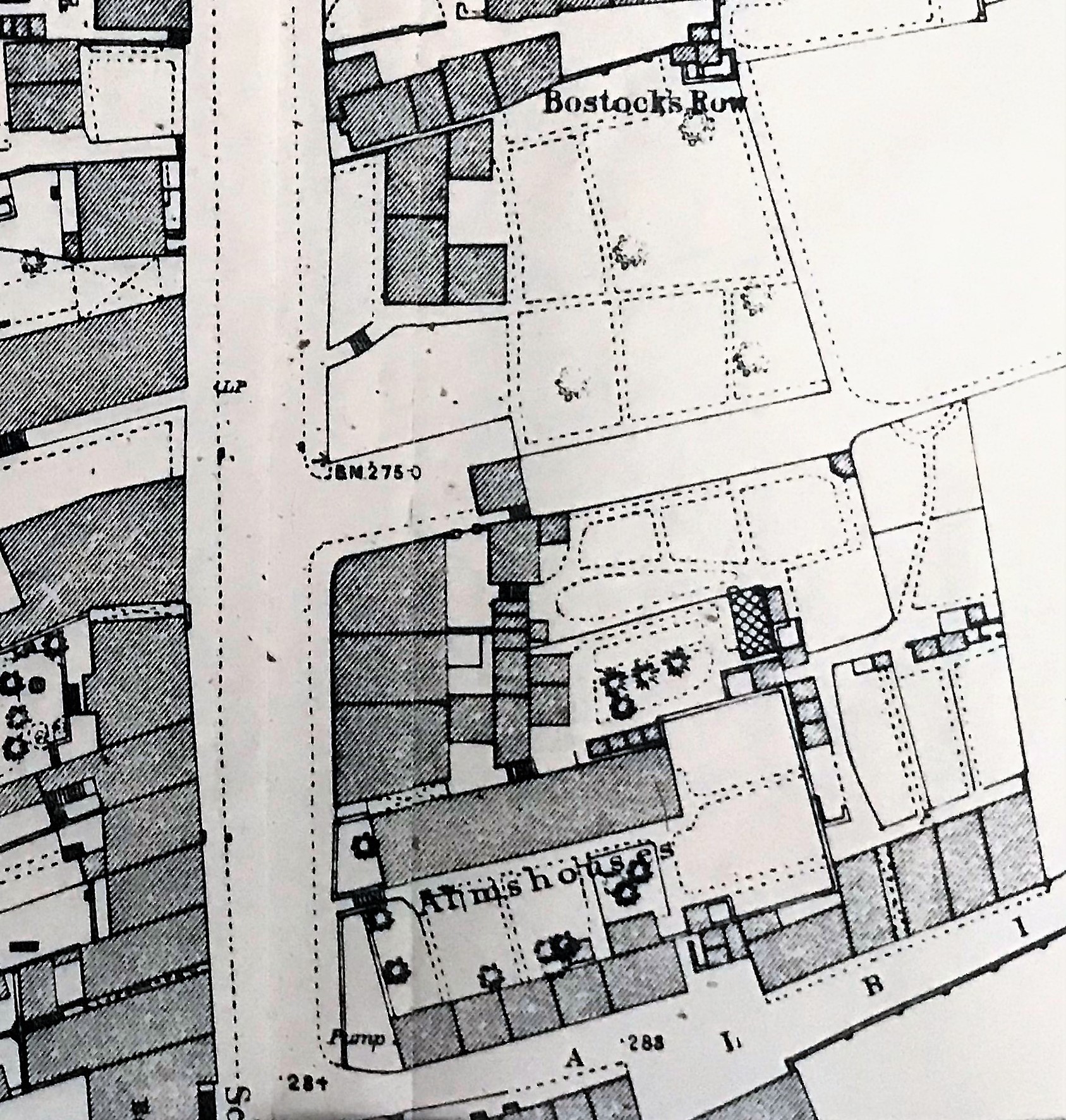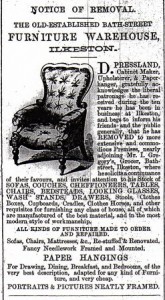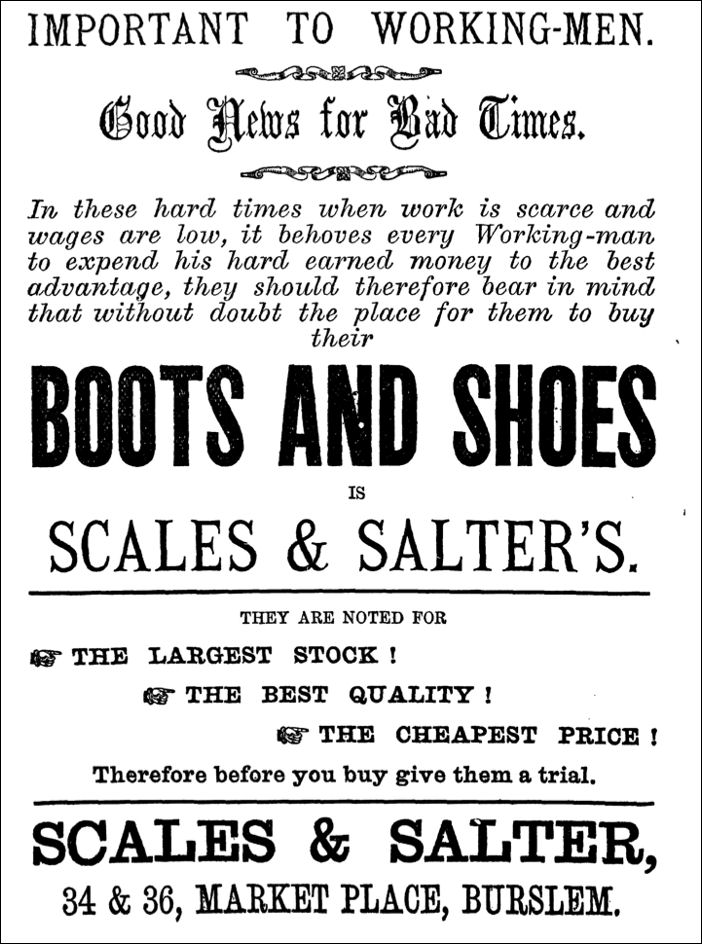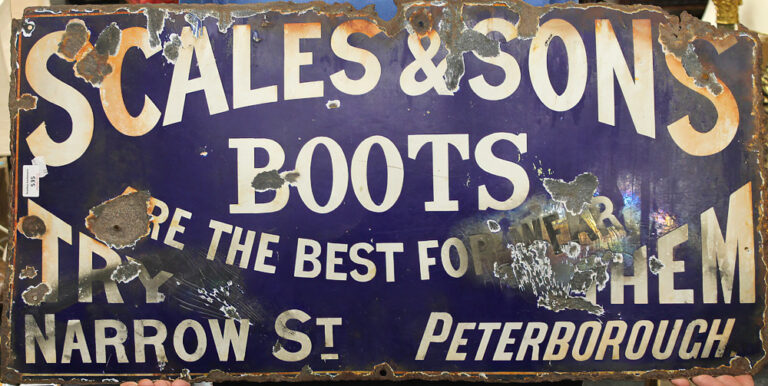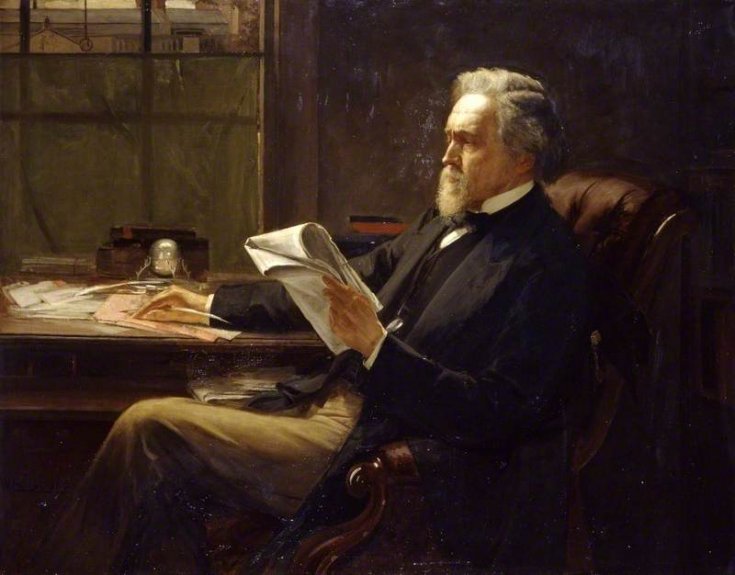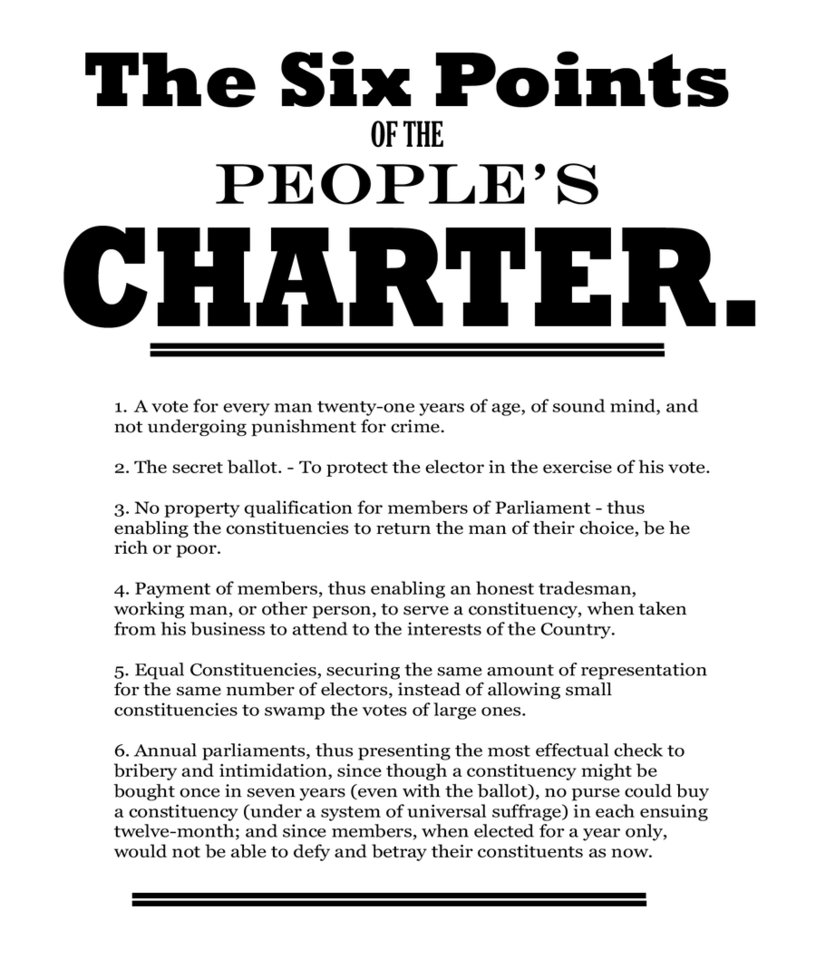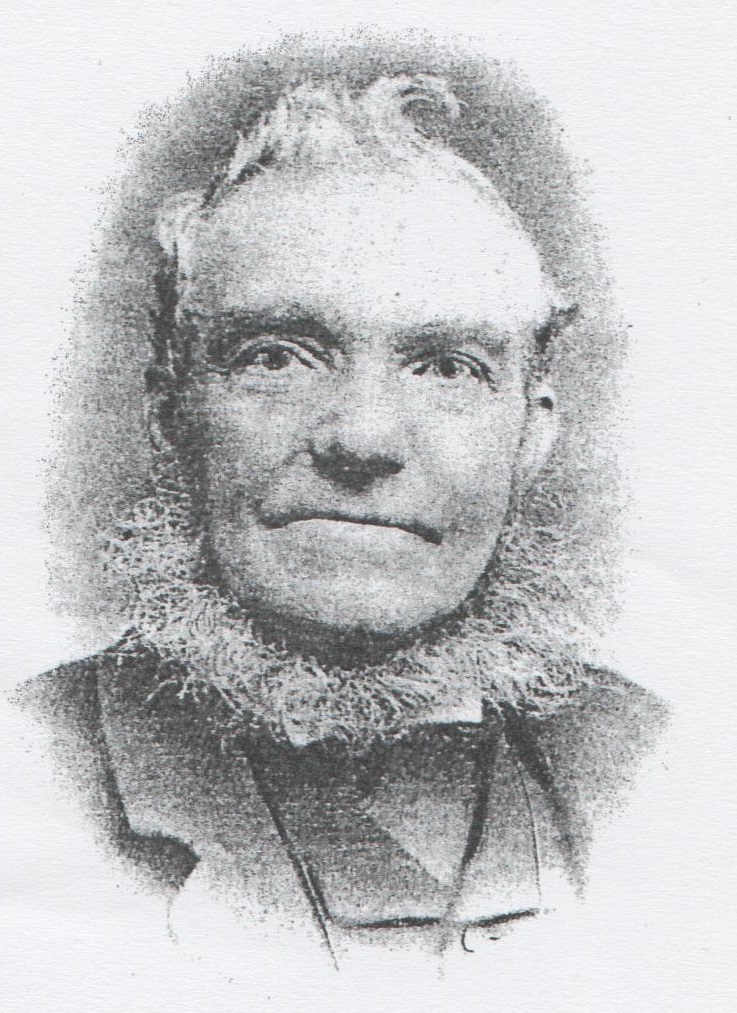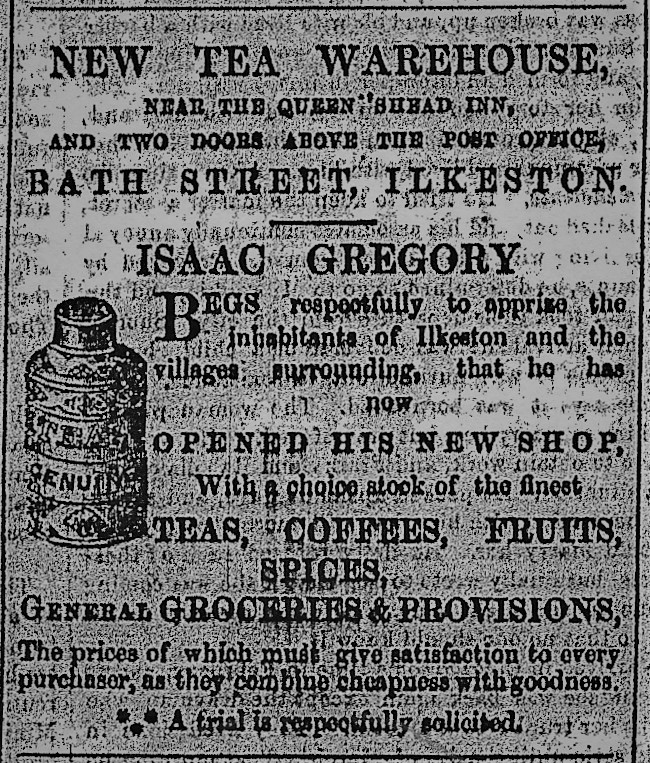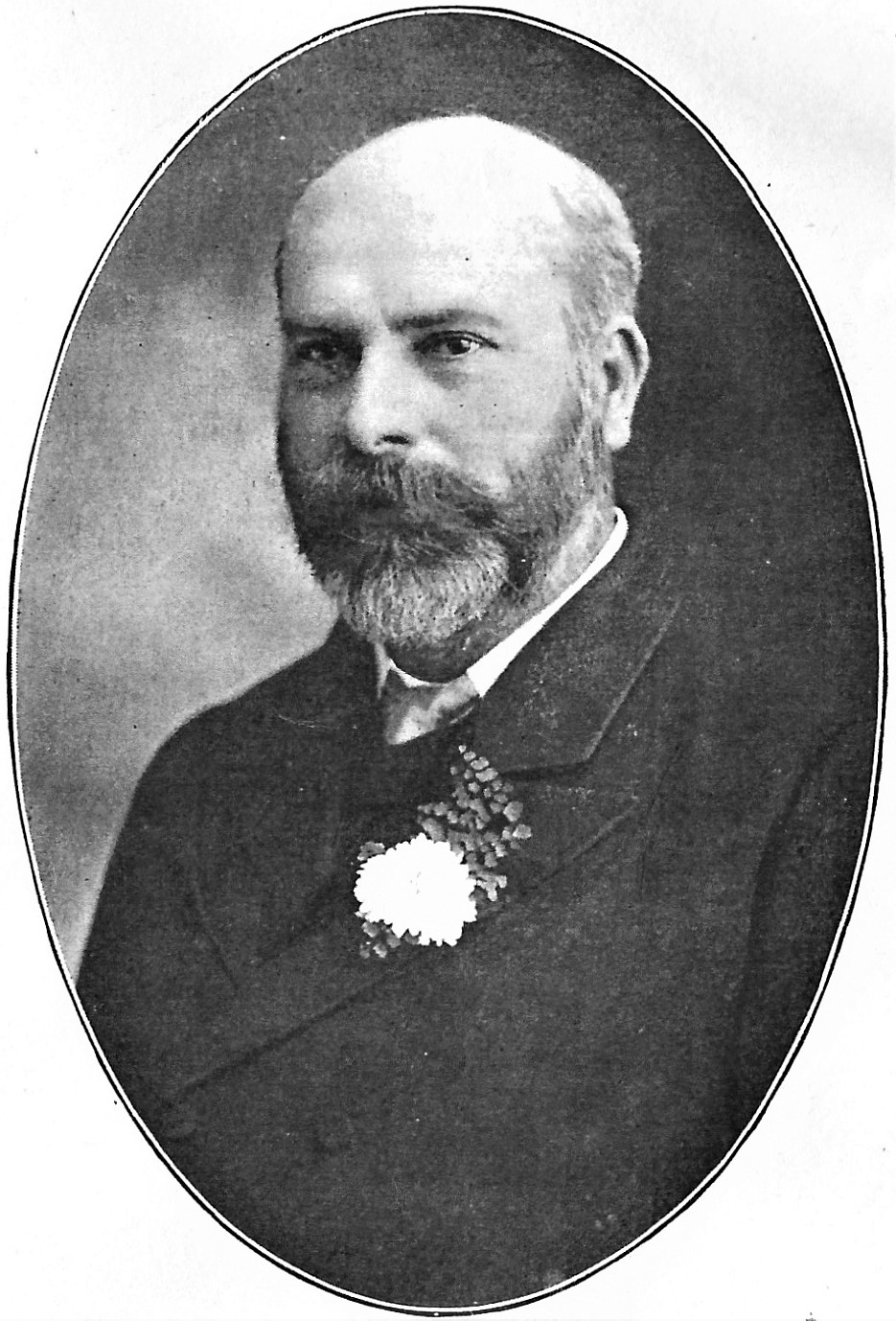After the Baker household Adeline continues up Bath Street towards the Market Place. leading us to a row of three premises, just below the Almshouses.
On the 1871 census they are numbered as 106, 107 and 108, followed by the Almshouses. Shortly before 1888 there was a radical renumbering of the Bath Street premises — number 106 became number 40, 107 became 38, and 108 became 36. Note that only even numbers were now found on this side of the street.
These premises were built about 1860.
“a row of three premises just before the Almshouses” (with Jack Lee’s Yard/Albion Place after)
Shop 1
(later 106 Bath Street, and then 40)
David Pressland was one of the first occupants of one of them.
By 1867 David had moved on to trade in the Market Place. Adeline maintains that it was “empty for a long time, and was afterwards taken by Scales & Salter’s, shoe people.
However before that, it was known as ‘Leeds House’ and was occupied by wholesale and retail shoe manufacturers H. Parker and J. Cupit.
This firm experienced financial difficulties and was bankrupt by the end of 1865.
At the end of March 1866 auctioneer Fred Paling offered for sale all the firm’s stock and capital equipment … 200 pairs of boots and shoes, laces, leather, iron and wood lasts, rolling machines, sewing and pricking machines, one weighing machine and a large cutting out machine, miscellaneous tools, fixtures, fittings and furniture.
It was then that, into the premises in that March moved Scales and Salter, boot and shoe stores, a firm which was already established in Leeds, Liverpool and Derby … and eventually in many other places !!
In 1866 the shop was granted permission by the Local Board to erect a window blind over the footpath.
William Richard Lawson came to Bath Street from Pudsey near Leeds about 1870 with his wife Martha and young daughter Clara Adelaide, to be the manager of the stores.
It was about 1886 that the firm of Scales & Salter became Scales & Sons. It traded as such into the next century … and at these same premises.
The Lawson family left about the same time that the firm changed its name. William Richard was replaced by Alfred Heesom.
But managers come and they go — by the turn of the century James Clancy and his family had arrived.
—————————————————————————————————————————————————-
Shop 2 .
….. in which we find Mr. Riley, glass and china dealer.
In 1871 this was 107 Bath Street (and then later, 38)
‘Radical’ Richard Riley, ’the man of pottery and pronounced heterodox principles’ (RBH) was another ‘foreigner’, born in Cheadle, Staffordshire in 1825 and coming from the Potteries, via Derby and Codnor to Ilkeston about 1861.
Richard had gone to work in the pottery industry at the age of 11 and as an apprentice learned his craft in the Potteries.
He seems to have been steeped in and receptive to the tradition of popular radicalism and trade unionism of the North Staffordshire area.
As a member and staunch supporter of the Potters’ Trade Union, Richard was influenced in early life by George Jacob Holyoake, a committed campaigner for secularism and Free Thought, an influence which was to last for the rest of his life.
Richard was also an agitator for the political reforms advocated by the Chartist Movement … on the right.
In 1847 Richard had married Mira Myatt, daughter of shoemaker John and Rebecca (nee Robinson) and as his family grew Richard found the pressures of earning a living combined with the strains and dangers of political agitation too much for him.
Consequently, at the age of 32 he left his native area to attempt to build up a business in Derby but experiencing financial difficulties there he moved on to Codnor. After initial success further problems led to his arrival at Ilkeston.
(Born in 1854 Richard’s first daughter was registered as Eleanor Holyoake Riley).
The 1861 census finds his family in Granby Street but he soon moved into Bath Street where he traded for the most of the rest of his life — although the 1891 census shows him at Jessop Street in Codnor, though still trading at Bath Street.
In November of the previous year he had been given an excellent character reference by two Ilkeston magistrates … and he needed it !!
Richard was in the dock at Derby Borough Court, charged by the RSPCA with working a horse while lame. The animal in question was hobbling on three legs, dragging a cart, laden with pots, and had arrived in Derby from Richard’s shop in Codnor. Its fourth foot suffered from ‘all the diseases it was susceptible to’. Richard pleaded ignorance .. he had bought the horse only a week or so earlier and argued that the lameness had developed on the way to market.
Perhaps the intervention of his ‘learned friends’ saved Richard from a larger fine than the 5s handed down to him.
Richard Riley was still trading at the same shop at the end of 1875 and William Richard Lawson was still managing the shoe retailing store next door. On the night of November 28th William Richard was approaching his back door, having just returned home, when he noticed a young man lying close by, a cup in each hand, several items of crockery surrounding him, and a large crate of further crockery also present. Putting two and two together, the manager decided that the man was up to no good !! The police were called by which time, with the help of his wife and neighbour Riley, the young man was ‘in custody’. Richard Riley identified 4 cream jugs and 34 tea cups … but it didn’t stop there. The young miscreant had earlier that evening visited the home of green-grocer John Chadwick, also in Bath Street and left with a hamper and several sacks, without James’s permission. A day earlier he had ‘picked up‘ a couple of jackets from the nearby shop of outfitter Edward Sutton and had had chance to pawn them with John Moss. and William Weatherhogg. All in all, it had been quite a profitable couple of days for young William Taylor — a pity for him that his luck had run out. At his subsequent trial at Derby William pleaded guilty to three charges of larceny and was sentenced to 6 months’ imprisonment for each — the sentences to be served consecutively !!
Richard died in February 1903 at 38 Bath Street.
His wife Mira had died at the same address two years earlier.
At his death an obituary, under the heading of ‘Trades Unionist, Chartist, Rationalist, Socialist’, appeared in the Ilkeston Advertiser written by Harry Silburn, bootmaker of South Street and ‘comrade’ of Richard or ‘Old Dad‘ as Harry called him.
Richard began work at the age of 11 and after his apprenticeship in the pottery trade, he became an active agitator in his trade union, taking part in the unsuccessful potter’s strike of 1836-7. About the same time, Richard and a few like-minded friends encountered trouble with the ‘Establishment’ of his Zion Chapel, were turned out, and so clubbed their meagre funds together to hire various lecturers, in a seasrch for ‘more light’. One such speaker was George Holyoake … a man of great influence upon Richard’s life. However incessant radical agitation took its toll on Richard’s health and so he moved to the Ilkeston area to build a business, He eventually settled in Bath Street where he was to live for the rest of his life.
Richard did not eschew his radical belifs however, but wrote regularly to the ‘Tribune’ and ‘Workman’s Times’, and brought speakers like Charles Bradlaugh and Annie Besant into the town. “He ran as a candidate for our local governing body, and, despite the unpopularity of his theological views, was nearly successful. (This was in 1887 when Richard tried to enter the Town Council for the Central Ward under the auspices of the Working Men’s Ratepayers Association). Some of the tactics resorted to by his opponents do not appear to have been of a very savoury character. At the inauguration of the Ilkeston branch of the Social Democratic Federation our comrade was one of the first members and remained to the last a firm consistent believer in our principles.
“Though debarred by the encroachments of old age from taking a very active part in our propaganda, his unwavering enthusiasm, his keen and merciless logic, his wide grasp of labour questions, his life-long habit of arguing from first principles, proved of immense advantage to the body of young men who surrounded him. And through it all he retained a freshness of spirit and cheerfulness of temper wonderful to see. Even the five weeks spent in bed previous to his death could not dim his cheerfulness nor break his spirit. He died as he lived, a blessing for all on his lips, calm, dignified, at peace with the world”.
“‘Life’s race well run; Life’s work well done. Now comes rest’ ”.
The Advertiser was also generous in its assessment of Richard.
“…none who really knew him could deny that his convictions were to him as real as existence itself…. The man who could cross swords with Richard Riley and come out unscathed was a man equipped with more than average intelligence and more than ordinary political and religious depth of thought. What Richard Riley might have accomplished had his mind been moulded on different lines who shall say? He deliberately chose to pay the penalty of adopting what he knew was the unpopular side in both religion and politics, and even those of us who believe he was on the wrong side in both must be ready to cast on his grave a laurel leaf of tribute to the sterling honesty of the man, who through good and ill report, often to his own private and public detriment, adhered with the tenacity of deep conviction to the things which he believed to be true”.
At this same time the Pioneer referred to him as “probably the oldest Socialist in the borough, recalling the many letters he wrote to the local press in the nom-de-plume of ‘Observer’”.
Richard was also remembered in ‘Justice‘, the weekly newspaper of the Social Democratic Federation (SDF), which recalled that he became a member of the Ilkeston branch of the SDF at its inception in 1893. Ill health had curtailed his contribution to ‘the cause’ however. Richard’s last wish was to hear his favourite song, ‘The Red Flag’, sung once more before his death … something which his pals, gathered around his bed, granted for him.
————————————————————————————————————————————————-
Shop 3
This was occupied by Mr. Isaac Gregory, grocer, and was known by locals as ‘the Old Cricket Depot‘ …. because of Isaac’s main passion (see below).
Adeline recalls that “Isaac’s wife was sister to Mr. Bob Marshall, of the White Lion, White Lion Square. Mr Gregory was a machinist at Ball’s, his wife attended to the shop. When they retired they lived at Gregory House, Gregory Street.
This shop was 108 Bath Street in 1871, and by 1888 had been renumbered as 36.
Isaac Gregory, son of Isaac and Mary (nee Skevington), was born on October 17th, 1824 and was initially employed as a collier like his father and later became engaged in the lace industry. On May 8th 1858 he married Sarah Marshall, youngest surviving daughter of Market Place grocer Thomas and Catherine (nee Jackson). They had no children.
Isaac served as an apprentice to William Ball before establishing a business as grocer and seedsman in Bath Street in 1857, remaining in that street for almost 30 years.
Harrod & Co’s trade directory of 1870 also describes him as ‘Foreign and British wine merchant’… his wine licence had been granted in August 1869.
In late 1874 Isaac had new shop premises built on the other side of Bath Street, almost opposite to his former premises. At the same time he applied for a licence to sell wines and spirits but this was refused. However in August 1875 he was licensed to sell wine, beer and spirits by retail off the premises, one of the very few licences granted to Ilkeston traders that year.
In January 1885 the business moved into Gregory Street, to be replaced — at what was then 17 and 18 Bath Street — by provision dealer Alfred Burton Wood, who had just moved from number 12, further up Bath Street.
At that time the premises were opposite the branch of Samuel Smith & Co’s Bank.
Isaac had connections with the old Highway Board and then was a member of the Local Board at intervals for many years, serving as treasurer and chairman for a short period.
He took an interest in Liberal politics, helping to form the Ilkeston Liberal club, and at the end of his life was one of its directors.
He was also a shareholder, a director and one of the managers of the Ilkeston General Cemetery Company.
When the town was incorporated, Isaac stood, unsuccessfuly, for election onto the first Town Council, in the Central Ward. He tried again in the November election of 1887, with the same result. Sadly he didn’t get a third chance.
Isaac was a keen cricketer for the Rutland Cricket Club, joining in 1845, and was described as “one of the best wicket-keepers in the country”.
On seven occasions he played for Derbyshire against All England as in 1851. In that match his batting was described as ‘scientific’ and ‘gave confidence to those who faced him’. His contribution of 24 not out in the first innings proved to be the highest Derbyshire score — and 24 more runs than he got in the second innings.
Since 1850 he had used his Bath Street premises as a ‘Cricketers Depot’ supplying patrons with requisites for the noble game. He retired from the game in 1865.
Isaac died at Gregory House, Gregory Street, at about nine o’clock on the evening of February 23rd 1888, aged 63, after an attack of bronchitis. The Pioneer could not resist linking his sporting life with his death.
“Death, the stumper who will shatter all our wickets in due course, found the old cricketer out of his ground, and he has been compelled to retire after playing a tolerably good innings”.
Gregory House, Gregory Street in November 2021 (with a modern extension, right)
And in 1888 Wright‘s Directory listed “Mrs Sarah Gregory, ale and porter merchant and seed dealer, Gregory street”.
Sarah also died at Gregory House, on April 7th 1905, aged 82.
Isaac and Sarah are buried together in St. Mary’s churchyard.
Isaac and Sarah occupying the crease together. Isaac would be happy with the site … against the graveyard wall next to the Old Cricket Ground.
Henry Thompson’s interlude
When Isaac moved out of his shop at number 108, into it came draper Henry Thompson. Born in Radford, Nottingham in 1850, Henry had arrived in Ilkeston about 1870 to work at the draper’s shop of Joseph Carrier, just up Bath Street from Isaac. On December 24th, 1878, he married Emma Moss, a daughter of South Street pawnbroker John Moss, and very soon was working independently as a draper at Isaac’s former premises. However, about 1884, Henry moved on and up …. up Bath Street that is !! Joseph Carrier had died in 1879 and now Henry moved up Bath Street to occupy Joseph’s former premises. Leaving number 108 vacant once more.
The arrival of George Andrew about 1884
George Andrew had arrived in Ilkeston in 1873 but it was just over ten years later that he moved into this shop in Bath Street. At that time it was described as possessing a nice two storied frontage, 25 feet in length and extending a good distance to the rear. There was a well appointed shop, stock and workrooms.
This is what Edwin Trueman had to write about George (Trueman 2 of 1911) …
After serving his apprenticeship with Mr John Farr, of Leighton, George came to Ilkeston, and took over the management of the ironmongery business of Thomas Merry.
Seven years later he commenced in business in Bath Street on his own account.
For a short time he was a member of the School Board; and he has filled the office of president of the Ilkeston Tradesmen’s Association since its inaugeration in 1898, and is a past President of the Nottingham District Ironmonger’s Association.
For a number of years he was a sidesman at the Parish Church, until August last, when he was elected people’s warden.
He is a member of the Mundy Grove Lodge of Freemasons.
At this shop, George sold stoves, grates, hearths, chimney pieces, all kinds of tools and cutlery, household and cooking utensils, builders’ ironmongery, and all sorts of agricultural implements … and employing a staff of iron and tinplate workers.
Towards the end of May 1888 there was a four-day exhibition of gas appliances, held at the Town Hall, and which included items from some of the most prestigious firms in the country — cooking stoves, heating appliances, burners, models of gas apparatus, photographs, and specimens of raw materials. George was one of only two Ilkeston tradesmen who took part — the other was Bath Street plumber William Henry Coupland. Did this mark him out as a ‘progessive’ ? Also at the exhibition, “Mrs Thwaites, of the Liverpool School of Cookery, delivered lectures on cookery”.
George died at Leighton House on New Lawn Road, Ilkeston on November 28th 1937.
————————————————————————————————————————————————–
Past the shop of Isaac Gregory but below Jack Lee’s yard and up some steps were the old Smedley’s Alms Houses.

